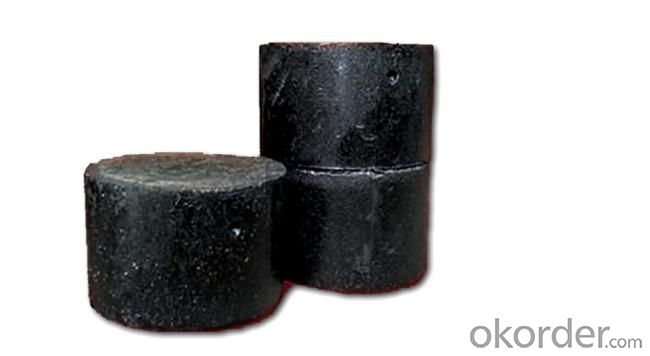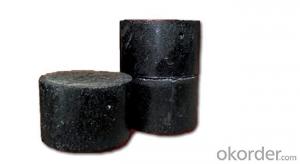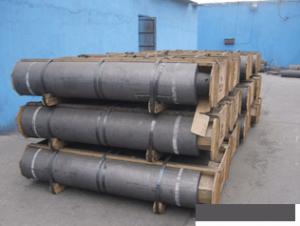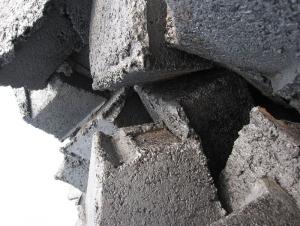cylinder Carbon Electrode Paste with different size
- Loading Port:
- Lianyungang
- Payment Terms:
- TT OR LC
- Min Order Qty:
- 20 m.t.
- Supply Capability:
- 800 m.t./month
OKorder Service Pledge
OKorder Financial Service
You Might Also Like
Spcifications
1:carbon eletrode paste
2:for ferroalloy,calcium carbide manufacture
3:HS 3801300000,YB/T5212-1996,ISO9001:2008
Product Description
Carbon Electrode Paste is a self-baking electrode used in submerged arc furnaces for delivering power to the charge mix. Electrode Paste is added to the top of the electrode column in either cylindrical or briquette form. As the paste moves down the electrode column the temperature increase causes the paste to melt and subsequently bake forming a block of electrically conductive carbon. Electrode Paste is essentially a mix of Electrically Calcined Anthracite (ECA) or Calcined Petroleum Coke (CPC) with Coal Tar Pitch.
Graphite/Carbon Electrode Paste Specification:
| PARAMETER UNIT GUARANTEE VALUE | ||||||
| Ash.( % ) | 4.0 max | 5.0 max | 6.0 max | 7.0 max | 9.0 max | 11.0 max |
| V.M (%) | 12.0-15.5 | 12.0-15.5 | 12.0-15.5 | 9.5-13.5 | 11.5-15.5 | 11.5-15.5 |
| Compress Strength. | 18.0 min | 17.0 min | 15.7 min | 19.6 min | 19.6 min | 19.6 min |
| Specific Resistance | 65 max | 68 max | 75 max | 80 max | 90 max | 90 max |
| Bulk Density | 1.38 min | 1.38 min | 1.38 min | 1.38 min | 1.38 min | 1.38 min |
Picture:
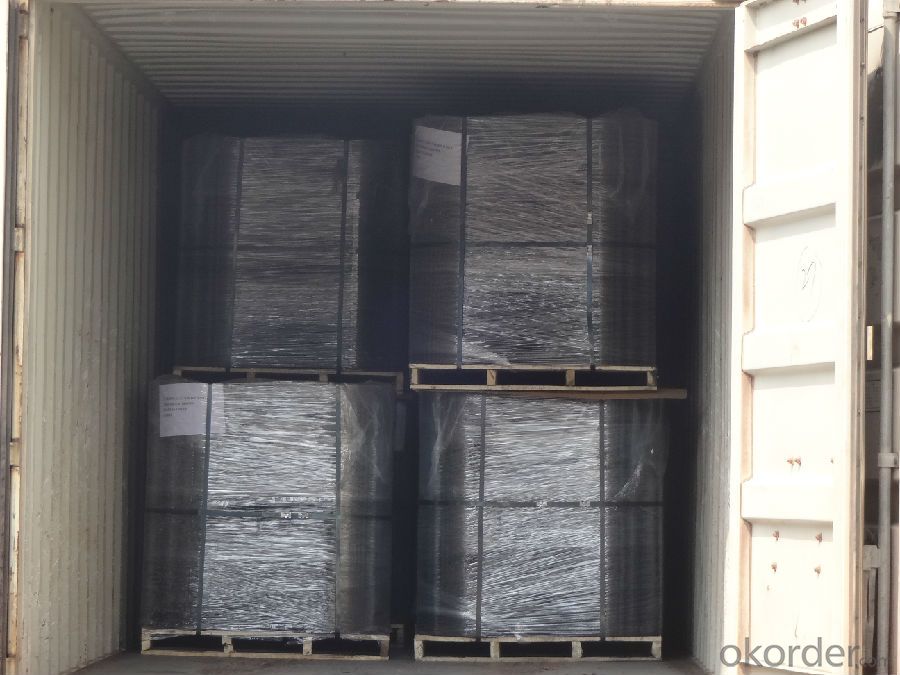
- Q: What is the role of carbon in the formation of fossil fuels?
- The role of carbon in the formation of fossil fuels is crucial. Fossil fuels, such as coal, oil, and natural gas, are formed from the remains of ancient plants and organisms that lived millions of years ago. These organisms were primarily made up of carbon-based compounds. Over time, the organic matter accumulated and was buried under layers of sediment, subjected to intense heat and pressure. This process, known as carbonization, caused the carbon within the organic matter to undergo chemical changes, transforming it into fossil fuels. Therefore, carbon is the key element involved in the formation of fossil fuels.
- Q: What are the carbon nanotube applications?
- The application of carbon nanotubes in composite materials: carbon nanotubes with nanoparticles in size effect, but also has high mechanical strength, good flexibility, high conductivity, unique properties, become the ideal reinforcement of polymer composites, is widely used in chemical industry, machinery, electronics, aviation, aerospace and other fields. But because of carbon nanotubes are easily assembled into bundles or wound, and compared with other nanoparticles, the surface is relatively inert, in common organic solvents or polymer materials dispersion in the low, which greatly restricts its application. Therefore, the surface of carbon nanotubes modified carbon nanotubes has become a research hotspot the polymer / composite material. At present, the domestic and foreign research on the surface modification of carbon nanotubes is mainly covalent and non covalent bond groups introduced on the surface, such as the use of the surface Chemical modification, surfactant modification, or by coating modification methods of carbon nanotube polymer molecules. In recent years is presented. The ultraviolet irradiation, plasma radiation modification and processing method. The surface modification of carbon nanotubes for polymer composites can significantly improve the mechanical properties, electrical properties and thermal properties.
- Q: How does carbon affect the migration patterns of animals?
- Carbon emissions and the subsequent increase in greenhouse gases have been found to have a significant impact on the migration patterns of animals. One of the key ways carbon affects migration is through climate change. As carbon dioxide levels rise, the Earth's temperature also increases, leading to alterations in weather patterns and the timing of seasons. These changes can disrupt the natural cues and signals that animals rely on to initiate migration. For some species, migration is triggered by changes in temperature, daylight hours, or the availability of food sources. However, with climate change, these cues may become inconsistent or altered, leading to confusion and disruption in migration patterns. For example, migratory birds rely on the availability of insects and other food sources during their journey, but changing temperatures and shifts in plant and insect life cycles can affect the timing and availability of these resources, potentially leading to food shortages and impacting their ability to complete their migrations successfully. Additionally, carbon emissions have led to changes in habitat and ecosystems that further influence migration patterns. Rising temperatures and changes in precipitation patterns can alter the distribution and abundance of plant species, which can, in turn, affect the availability of food and shelter for migratory animals. Some species may find their traditional breeding or feeding grounds no longer suitable due to these changes, forcing them to alter their migration routes or patterns. Furthermore, carbon emissions also contribute to the melting of polar ice caps and the subsequent rise in sea levels. This has a direct impact on marine species that rely on specific breeding grounds or feeding areas. As their habitats shrink or disappear, these animals may be forced to migrate to new areas or face extinction. Overall, the increase in carbon emissions and resulting climate change have profound effects on the migration patterns of animals. Disruptions in weather patterns, altered cues for migration, changes in habitat, and shifts in food availability all contribute to the challenges faced by migratory species. Understanding and mitigating the impact of carbon on migration is crucial to ensure the survival and well-being of these animals in a rapidly changing world.
- Q: Where do I buy DNF premium advanced carbon?
- Seems to be in the mall in the wish gift box, oh, do not remember, I do not know, is not it?! Look, I haven't played that game for a long time. I hope I can help you
- Q: Why does the carbon content of steel increase and the mechanical properties change?
- 3, according to the forming method classification: (1) forging steel; (2) cast steel; (3) hot rolled steel; (4) cold drawn steel4., according to chemical classification(1): A. carbon steel low carbon steel (C = 0.25%); B. (C = 0.25~0.60%) in carbon steel high carbon steel; C. (C = 0.60%).(2): A. alloy steel, low alloy steel (alloy element content is less than or equal to 5%) B. alloy (5~10% alloy element content, high alloy steel (C.) alloy element content > 10%).5. Classification according to metallographic structure(1) annealed state of A. eutectoid steel (ferrite + Zhu Guangti), B. eutectoid steel (Zhu Guangti), C. eutectoid steel (Zhu Guangti + cementite), D., bainitic steel (Zhu Guangti + seepage body)(2) normalizing condition: A. pearlitic steel; B. bainitic steel; C. martensitic steel; D. austenitic steel(3) no phase change or partial phase change occurs6, according to smelting method classification(1) according to the kind of furnaceA.: open hearth steel (a) acid open hearth steel; (b) basic open hearth steel.B. converter steel: (a) the Bessemer steel; (b) basic Bessemer steel. Or (a) bottom blown converter steel; (b) (c) side blown converter steel; BOF steel.C. electric furnace steel: electric arc furnace (a) steel; steel electroslag furnace (b); (c) induction furnace steel; (d) vacuum consumable steel; (E) electron beam furnace.(2) according to the degree of deoxidization and pouring systemA. boiling steel; B. semi killed steel; C. killed steel; D. special killed steel
- Q: What are the consequences of increased carbon emissions on indigenous communities?
- Increased carbon emissions have significant consequences on indigenous communities. Firstly, these communities often rely on the land and natural resources for their livelihoods, so environmental degradation caused by carbon emissions can directly impact their ability to hunt, fish, and gather food. Additionally, climate change resulting from carbon emissions leads to more frequent and intense natural disasters, such as hurricanes and droughts, which can destroy homes and infrastructure in indigenous communities. Moreover, the loss of traditional knowledge and cultural practices associated with the changing environment can have profound social and psychological impacts on indigenous peoples. Overall, increased carbon emissions exacerbate existing inequalities and vulnerabilities faced by indigenous communities, threatening their way of life, well-being, and resilience.
- Q: What are the effects of carbon emissions on the stability of urban infrastructure?
- Urban infrastructure stability is significantly impacted by carbon emissions. The atmosphere is polluted with carbon dioxide and other greenhouse gases from different sources like industrial activities, transportation, and energy production, resulting in climate change. This, in turn, poses numerous challenges to urban infrastructure. Among the primary effects of carbon emissions on urban infrastructure stability is the increased frequency and severity of extreme weather events. Climate change leads to more intense heatwaves, storms, hurricanes, and flooding, causing substantial damage to buildings, roads, bridges, and other infrastructure components. Higher temperatures also cause materials to expand and contract, resulting in structural issues and reduced durability. Additionally, rising sea levels caused by carbon emissions contribute to the melting of polar ice caps, putting coastal cities at risk of flooding and erosion. This threatens critical infrastructure in these areas, such as ports, water treatment facilities, and transportation systems. The stability of urban infrastructure is compromised as sea levels continue to rise. Carbon emissions also impact energy supply and demand, affecting urban infrastructure stability. Climate change leads to extreme weather events that disrupt power grids and energy infrastructure, resulting in blackouts and service disruptions. Moreover, the increased demand for cooling systems due to rising temperatures can strain existing infrastructure and overload the electrical grid. Furthermore, carbon emissions contribute to air pollution, which negatively affects the health and well-being of urban populations. Poor air quality leads to respiratory and cardiovascular diseases, impacting the workforce and productivity. This indirectly affects the stability of urban infrastructure, as a healthy and productive population is crucial for the functioning of cities. To mitigate the effects of carbon emissions on urban infrastructure stability, various measures can be implemented. These include transitioning to renewable energy sources, improving energy efficiency in buildings and transportation, implementing sustainable urban planning strategies, and investing in climate-resilient infrastructure. These actions can reduce carbon emissions and build infrastructure capable of withstanding the challenges posed by climate change, ultimately ensuring the stability and resilience of urban areas.
- Q: How does carbon dioxide affect the formation of smog?
- Carbon dioxide does not directly contribute to the formation of smog. However, it indirectly influences smog formation by contributing to climate change, which can lead to increased temperatures and the formation of ground-level ozone, a key component of smog.
- Q: I want to make a rectangular round bar for bearing. What carbon fiber and carbon fiber should be used? How should I do it? What kind of machine does it use to dry it?
- Not really. Carbon fiber is only a reinforcing material, similar to glass fiber, without cohesive force.In general, the carbon fiber cloth is to be made of pre impregnated fabric by wet or melting method, and then cut, then laid or rolled to form the embryo according to the shape to be made. Finally, the mold is heated and pressurized and shaped.Plastic molding may be referred to
- Q: What is the importance of carbon dating in archaeology?
- Carbon dating is of utmost importance in archaeology as it plays a crucial role in determining the age of artifacts and archaeological sites. This scientific method allows archaeologists to establish a chronological framework and understand the timeline of human history. The technique of carbon dating relies on the fact that all living organisms contain a certain amount of radioactive carbon-14, which decays at a predictable rate over time. By measuring the amount of carbon-14 remaining in an artifact or organic material, archaeologists can calculate its age. This method is particularly useful for dating organic remains, such as bones, charcoal, and plant fibers, which are often found at archaeological sites. The importance of carbon dating lies in its ability to provide a precise and reliable estimation of an artifact's age. This information is crucial for interpreting and understanding the context and significance of archaeological finds. By assigning an accurate date to an object or site, archaeologists can establish connections between different artifacts, societies, and cultures. This, in turn, helps to reconstruct ancient civilizations and their development over time. Furthermore, carbon dating is also valuable for refining and validating historical timelines. It allows archaeologists to cross-reference and verify the dating of artifacts and sites using other dating methods, such as dendrochronology (tree-ring dating) or stratigraphy (the study of rock layers). The combination of multiple dating techniques enhances the accuracy and reliability of archaeological interpretations. Carbon dating also assists in identifying and distinguishing between genuine artifacts and forgeries. By analyzing the age of an object, archaeologists can determine if it aligns with the historical context it claims to belong to. This is particularly important in the field of art and antiquities, where the market for fakes and forgeries can be lucrative. Overall, carbon dating is a vital tool in archaeology as it allows researchers to establish the chronology of ancient civilizations, validate historical timelines, and identify genuine artifacts. It provides valuable insights into our past, helping us better understand and appreciate the rich tapestry of human history.
Send your message to us
cylinder Carbon Electrode Paste with different size
- Loading Port:
- Lianyungang
- Payment Terms:
- TT OR LC
- Min Order Qty:
- 20 m.t.
- Supply Capability:
- 800 m.t./month
OKorder Service Pledge
OKorder Financial Service
Similar products
Hot products
Hot Searches
Related keywords



